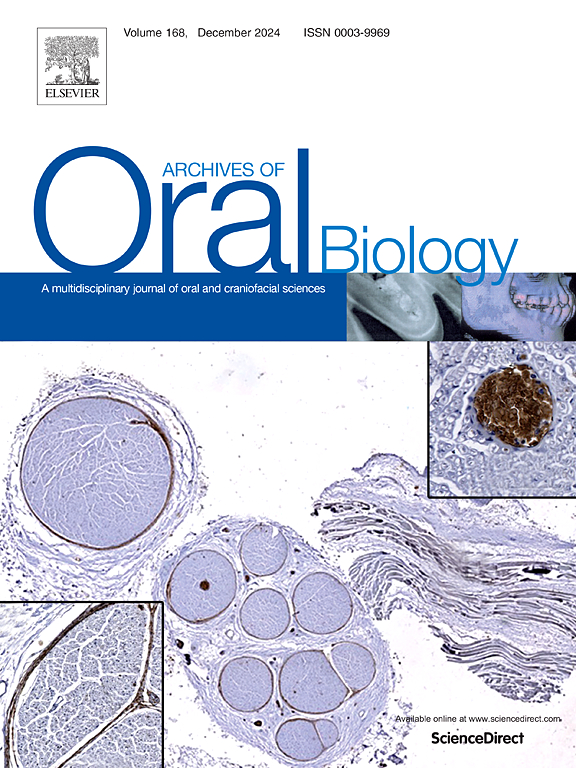In Vitro antibacterial activity of Lactiplantibacillus sp. cell-free supernatants against Porphyromonas gingivalis: A potential approach for oral health
IF 2.1
4区 医学
Q2 DENTISTRY, ORAL SURGERY & MEDICINE
引用次数: 0
Abstract
Objective
This study explores the potential of postbiotic metabolites from lactic acid bacteria (LAB) isolated from human milk and tempeh against Porphyromonas gingivalis, a key pathogen in periodontitis.
Design
Selected LAB strains and their treated cell-free supernatants (TCFS), lyophilized TCFS (L-TCFS), and bacteriocin-like inhibitory substances (BLIS) were tested individually and in combination using agar well diffusion, MIC, MBC, autoaggregation, coaggregation, and biofilm inhibition assays. LAB identification was performed using the API 50 CHL kit and 16S rDNA sequencing.
Results
Strain S2, a mixture of Lactiplantibacillus sp. SUK1 and T2 showed the highest inhibitory activity (20.06 ± 4.14 mm) using the agar well diffusion method. It demonstrated strong autoaggregation compared to the individual T2 strain but lacked significant coaggregation ability. The L-TCFS of S2 also exhibited the strongest antibacterial effect, with a minimum inhibitory concentration (MIC) of 50 mg/mL, although no minimum bactericidal concentration (MBC) was detected for any bacteriocin-like inhibitory substances (BLIS). L-TCFS from strain S2 significantly reduced P. gingivalis biofilm formation at a minimum concentration of 25 mg/mL, compared to the untreated control. Strain T2 was identified as Lactiplantibacillus plantarum using the API 50CHL test and 16S rDNA gene sequencing.
Conclusion
The combination metabolite S2 demonstrates promising inhibitory activity against P. gingivalis and may serve as an effective adjunctive therapy for periodontal infections, outperforming individual and other combination LAB strains tested.
无细胞乳酸杆菌上清液对牙龈卟啉单胞菌的体外抗菌活性:一种潜在的口腔健康方法
目的探讨乳酸菌(LAB)对牙周炎病原菌牙龈卟啉单胞菌(Porphyromonas龈卟啉单胞菌)的拮抗作用。设计选定的实验室菌株及其处理过的无细胞上清液(TCFS)、冻干TCFS (L-TCFS)和细菌素样抑制物质(BLIS)分别和联合使用琼脂孔扩散、MIC、MBC、自聚集、共聚集和生物膜抑制试验进行检测。使用API 50 CHL试剂盒和16S rDNA测序进行LAB鉴定。结果由乳酸菌SUK1和T2混合而成的S2菌株在琼脂孔扩散法下的抑菌活性最高(20.06±4.14 mm)。与单个T2菌株相比,它表现出较强的自聚集能力,但缺乏显著的共聚集能力。S2的L-TCFS也表现出最强的抑菌效果,最低抑菌浓度(MIC)为50 mg/mL,但未检测到任何细菌素样抑制物质(BLIS)的最低杀菌浓度(MBC)。与未处理的对照相比,菌株S2的L-TCFS在最低浓度为25 mg/mL时显著减少了牙龈卟啉卟啉菌生物膜的形成。菌株T2经API 50CHL检测和16S rDNA基因测序鉴定为植物乳杆菌。结论联合代谢产物S2对牙龈假单胞菌具有良好的抑制作用,可作为治疗牙周感染的有效辅助药物,其效果优于单个和其他联合LAB菌株。
本文章由计算机程序翻译,如有差异,请以英文原文为准。
求助全文
约1分钟内获得全文
求助全文
来源期刊

Archives of oral biology
医学-牙科与口腔外科
CiteScore
5.10
自引率
3.30%
发文量
177
审稿时长
26 days
期刊介绍:
Archives of Oral Biology is an international journal which aims to publish papers of the highest scientific quality in the oral and craniofacial sciences. The journal is particularly interested in research which advances knowledge in the mechanisms of craniofacial development and disease, including:
Cell and molecular biology
Molecular genetics
Immunology
Pathogenesis
Cellular microbiology
Embryology
Syndromology
Forensic dentistry
 求助内容:
求助内容: 应助结果提醒方式:
应助结果提醒方式:


